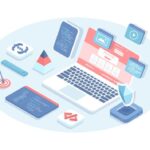Skills Required to Become a Pro UX Designer
When it comes to user experience design, it’s a great moment to get started! (UX design).
In order to become a UX designer, you may take a number of different routes. The ability to demonstrate that you possess the necessary abilities is frequently a deciding factor in securing a job.
What are the requirements for a UX designer?
User experience (UX) designers employ a mix of technical and interpersonal abilities in their work. In the field of UI/UX, you’ll need some of these talents, while others are more universal. You may already have abilities that may be used in a new job in website ux design.
- Wireframes, user flows, mockups, and prototypes
Imagining what a product will look like is a major aspect of the product development process. Wireframes, low or high-fidelity prototypes, mockups, or user flows may all be used in this process. These concepts need to be defined. User demands are prioritized on a web page’s wireframe, removing any visual design aspects.
For testing and gathering feedback, a prototype is a sample or imitation of a finished product. It is possible to create low-fidelity prototypes by drawing them on paper, but they do not allow for user interaction. Most high-fidelity prototypes are computer-based and include a mouse and keyboard for user input. An application or a website mockup is a realistic visual representation of the final product.
In order to master these aspects of interface design, one must get their hands dirty. Fortunately, all you need is a pen and paper to get started. Get acquainted with the components of a popular app or website by sketching up wireframes and user flows.
Mockups and prototypes often need specialized user experience (UX) tools. Prototyping tools like as InVision, Sketch, and Adobe XD often provide a free trial period that enables you to develop several prototypes before you have to subscribe.
With a pen and paper, you may make affordable paper prototypes. They also make it possible to iterate quickly. With only pen and paper, you’ll be able to swiftly create paper prototypes for many different concepts.
- Software for visual design and design
Visual design software like Figma, Sketch, Photoshop, and Illustrator are tools used by both UX and UI designers to build a product’s visual features. Visual design best practices, including typography, color theory, layout, iconography, and design philosophy should be learned in addition to competency in the tools.
- Usability testing and user research
To create a product that delights a user by solving a problem, meeting a need, or meeting a desire, you must first identify the target audience. Using user research is the answer to this problem.
You can make a product even better if you do the proper user research. You’ll undertake user testing as you build prototypes to ensure that your design decisions are sound. These two user-centered stages may help you become a more successful designer.
Because of the importance of this talent, several firms have created the position of “UX researcher” inside their UX departments.
- Adaptability is essential.
The iterative process of creating a product is at the heart of the agile project management approaches that have become prominent in the software development industry. It seems obvious that UX design agency would benefit from a grasp of the agile technique, which is used by many software development teams.
Agile UX design is a concept used to describe the growing convergence of UX and agile methodologies. As a UX designer, it isn’t necessary for you to know every tidbit of project management in order to be successful.
- The design of information systems
It is the art and science of organizing and structuring information in a way that is efficient and effective. IA may assist users discover the information they need or finish a job if it is designed correctly. Make it simple for the user to know where they are, what they need and where they’re going next.
First, familiarize yourself with some of the most frequent website IA patterns. As with wireframing, you may practise by designing a sitemap for a website or app that you love using. Make a few attempts at this, and see if you can figure out what makes for excellent IA.
- The creation of applications
To be a good user experience (UX) designer, you need to be familiar with the basics of application development, such as JavaScript, CSS, and HTML. As a UX designer, you may benefit from learning about how apps are built.
With more realistic assumptions about your design’s potential, you’ll come up with better solutions. You’ll be able to work more effectively with the development team.
You may have a better chance of landing a job at a small start-up company since they tend to employ a broader variety of competencies.
If you decide to pursue a career in UX design or UI development, you’ll have a solid foundation in coding.
- Collaboration
In your role as a UX designer, you’ll often be working with members of different teams. Your team may collaborate with business executives to identify business objectives, UI designers to add visual aspects to a mockup or high-fidelity prototype, and developers to put your concepts into code.
Incorporating new ideas and working as a cohesive unit is an important component of any job that requires collaboration.
- Presentation and communication skills
One cannot function without the other. When it comes to communication, you’ll have a lot more than simply your own staff to deal with. When performing user research and presenting your ideas, strong communication skills may help you acquire more meaningful data from consumers and inspire stakeholders. Effective visual and textual communication (UX writing) are typically necessary for good UX.
- Time management and prioritization
Companies are generally searching for UX designers that can manage their time and prioritize work to meet the most crucial demands first. During the course of a day, you may find yourself working on various projects (or sections of the same project). Work on being organized and adaptable in your present job so that you may succeed in the field of user experience design.



